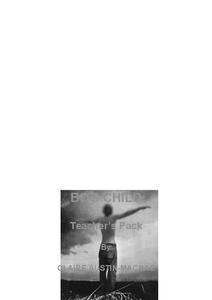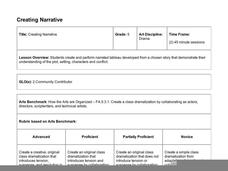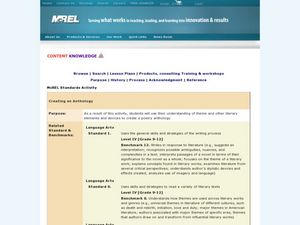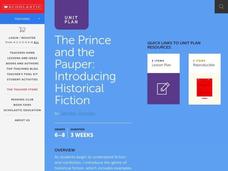Curated OER
Story Elements
Students create a "character T-shirt" that exemplifies their ability to analyze a character. The students also compare and contrast characters in a given story. Finally, the students write a presentation about the story's characters,...
Curated OER
One Ring to Rule Them All
Students continue to read Tolkien's Lord of the Rings. In groups, they analyze the different metaphysical aspects of the ring and discuss the characters use of power in the story. As a class, they examine Frodo's reasoning for wanting...
Curated OER
Incorporating Literature into Social Studies Teaching and Learning
Students engage in a study of incorporating literature into the Social Studies classroom. They review a variety of literature sources and then create a bulletin board with the information. Then students practice using the Reader's...
Curated OER
Using Children's Literature to Teach Writing: No, David!
Students review beginning, middle, and end of a story and how details add to a story.
Curated OER
All About Me
High schoolers examine their own personality traits and preferences. They use this information to write an autobiography.
Curated OER
Archaeology and Storytelling
Young scholars identify and interpret both individual families and whole cultures learn about their pasts by collecting and analyzing stories and artifacts. Then they identify that not all archaeological finds readily reveal their...
Curated OER
Bog Child
You are destined for an engaged and happy class as they read Siobhan Dowd’s Bog Child because there is nothing missing from this study guide, seriously. This might be the easiest novel to teach because you don’t have to do a thing in...
Curated OER
Graphic Novel Writing Workshop
Khaled Hosseini’s video “Using Real People and Events” motivates learners to reflect on their own experiences and to use those experiences as the basis of a graphic novel that expresses a universal truth. The richly detailed plan...
Curated OER
Fifth Grade Literature: January
Fifth graders examine and analyze various poems by Edward Hersey Richards, Robert Frost, and Emily Dickinson. They explore similes, and write journal entry responses.
Hawaiʻi State Department of Education
Creating Narrative
Plot, setting, characters, and conflict are common to both drama and narrative stories. Kids create narrated tableaus that show their understanding of the plot, setting, and conflict of a story they've recently read. The lesson plan...
Curated OER
Creating an Anthology
Student compile a poetry anthology. In this literature lesson, students examine notable poetry anthologies. Students then select a theme to build their anthologies of 10 poems pertaining to their chosen theme.
Curated OER
Poetry Analysis Device: TPCASTT
Students analyze the key elements of poetry using a mnemonic device. The device: TPCASTT (title, paraphrase, connotation, attitude, shifts, title and theme).
Curated OER
Song of Solomon by Toni Morrison: Quiz
In this Song of Solomon by Toni Morrison worksheet, students answer fifteen multiple choice questions about plot, characters, and theme as well as identify quotations.
Curated OER
A Long Time Ago in the Future
Students read and discuss Canadian young adult literature. They compare/contrast the elements of citizenship, characterization, and themes, write journal responses, and identify the elements that define Canadians.
Curated OER
The Individual and His Role in Society
Tenth graders discover how various writers approach the themes of : alienation and solitude, living life "deliberately" and "phonies." Through reading, journaling, class discussion, and writing assignments they realize the power of the...
Curated OER
Science Fiction
Learners write a science fiction story. In this science fiction activity, students read selections of science fiction and compare them to supernatural stories from the Bible. Learners identify themes and discuss elements that are...
Curated OER
Tracking Down Meaning in Great Expectations
Fourth graders are assigned an unique theme, symbol, or character in Great Expectations. They becomes the class expert on that facet of the novel while learning the basic skills needed to write a research paper.
Curated OER
The Witch of Goingsnake
Learners interpret a proverb and read examples of oral histories. In this The Witch of Goingsnake lesson, students read two samples of oral history and discuss quotations from each. Learners read "Calf Roper's Bandit Car" and interpret...
Gwinnett County Public Schools
Analysis of the Tuck Everlasting and The Birchbark House Text Exemplars
Looking to introduce some text-based questions into your ELA lessons? Practice the kinds of skills the Common Core demands with the seven text-based questions and the essay prompt provided here. Designed to be a three-day lesson, day one...
Curated OER
We Are Alike, We Are Different:A Focus on Japan
First graders develop a connection with students in a first grade classroom in Japan. They begin to develop a curiosity about Japan--the landscape, the people, and their culture, while developing an understanding of the Five Themes of...
Curated OER
Abuela's Weave Teacher's Guide
Students read and response to the book, Abuela's Weave. In this African-American literature activity, students discuss pre-reading questions, that focus on family traditions and make predictions about the text. Students read the text and...
Curated OER
Searching for Stars
Positive character traits in literature are explored in this character development and literacy lesson plan. Learners listen to Cinderella by Charles Perrault and Little Gold Star by Robert D. San Souci, followed by a discussion...
Curated OER
The Prince and the Pauper
Mark Twain, the famous American author, is often studied in the school system. Use "The Prince and the Pauper" to analyze the differences between the text and its video version. This lesson includes several culminating project ideas for...
Hawaiʻi State Department of Education
ABA Form in Music
Patterns happen everywhere, in music, math, and language! Fourth graders listen to the "William Tell Overture" visualizing the patterns that they hear. They then discuss and write an ABA poem that matches the ABA form found in the music...








